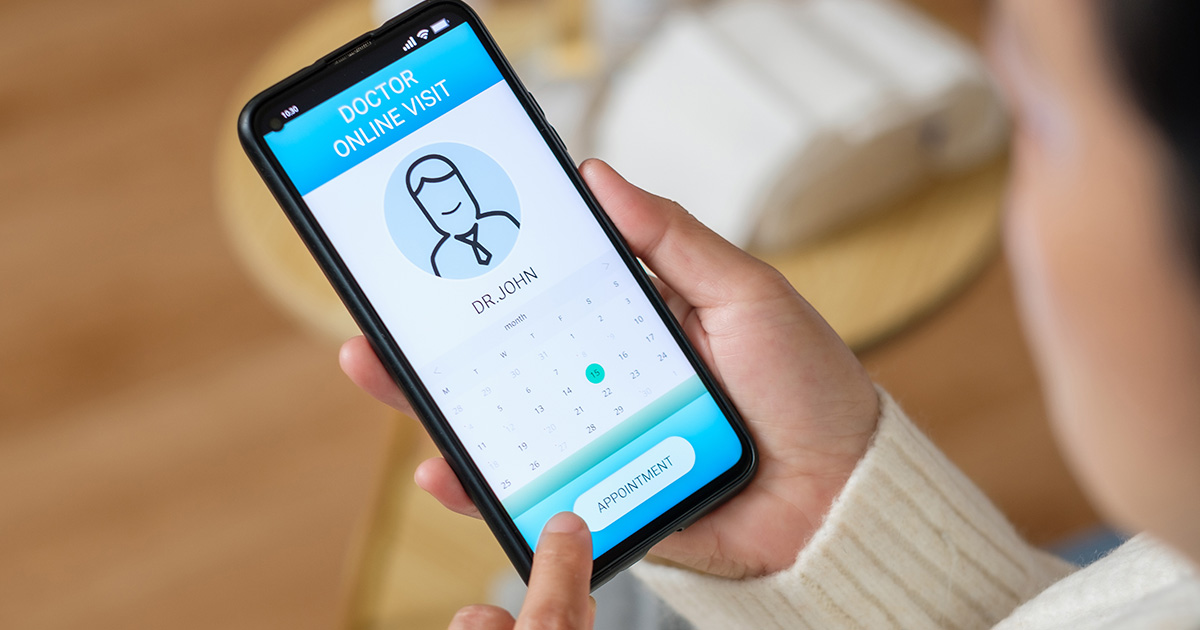Online patient scheduling helps keep your schedule full…and your patients satisfied
Good scheduling practices are the lifeblood that flows through your practice and helps keep it thriving and healthy. Here, we’ll outline the most critical components of scheduling effectively in today’s resource-challenged but customer-centric and value-driven healthcare environment.
Leveraging the power and convenience of online scheduling
Are you already using some form of online scheduling? Are you and your patients happy with it? If the answer to either question is no, don’t worry…there’s never been a better time to introduce the latest options to your patients and your team. With their growing use of the internet to gather information and order goods and services, today’s patients also expect the same ability to learn about your practice and self-schedule their health appointment…all when and where it’s convenient for them. After all, if you can schedule maintenance work for your car online from your favorite shop, why not book or at least request a routine visit to your healthcare provider?
How do we know that most people are ready for something they may have resisted not too long ago? According to 2020 statistics, 43% of patients prefer to book their appointments online — a figure that continues to increase each year. The pandemic certainly has made so many people — many patients — become much more accustomed to using the web to reach out to the world. And while they’ve increased their usage for the sake of safety, they’ve also become accustomed to its convenience and ease of use. In short, Mikey likes it…Mikeys of all ages.
Those recent statistics also show that 68% of patients say they’re more likely to visit practices that enable them to book, change and cancel appointments online. They’re tired of waiting on hold for someone to pick up the phone line. They’re frustrated they have to wait until your office opens, or that your staff returns from lunch or from the weekend. They want to reach out when they think about it. Otherwise, they may forget, and care services can be delayed.
And, frankly, patients want to know that you as their health provider have a modern, patient-centric practice…one that thinks about their convenience, not just yours. So whether or not they regularly take advantage of the online scheduling tool you choose to offer, just knowing they have the option improves their perception of you and, likely, their satisfaction. And from a marketing perspective, that can be priceless when they tell friends and family about you.
Make sure everybody knows
With all of this in mind, if you’re still expecting patients to book solely over the phone, today your practice is simply missing out on business. Depending on how you want your system set up, patients using online scheduling can often fill in unexpected gaps and pick up a same-day or next-day appointment, delivering more (and more timely) service and driving more of your revenue.
So don’t be shy about promoting your scheduling convenience as part of your staff’s in-person or telehealth encounters and across your communication vehicles. Be sure to promote and link to your online scheduling solution prominently on your website, your patient portal, in monthly newsletters and other emails to your current patients, and on social media or wherever else your practice has an online presence. Educate them, and many will come.
Promote convenience of completing intake forms in advance
We’re all busy, patients included. So once someone’s requested an appointment online (or even by phone), also encourage them to check, update or add information to their record as part of the pre-visit experience — their latest COVID-19, flu or pneumonia vaccines, a medication change by any of their healthcare providers, etc. When patients have the option to fill out their intake forms remotely, again you’re enabling them to finish their “paperwork” before their appointment…or, worse yet, to back up your schedule by completing history, insurance and other intake forms in your reception area at the time of their appointment. Again, subtly but definitely promote the convenience for them to have this completed at a time and location of their choice, but prior to their visit.
Not only does this create a better patient onboarding experience, it makes the job of your front-desk staff much easier as well. It decreases the bottleneck in the reception area. Depending on your arrival rules, especially during this ongoing pandemic, that means your patients can arrive for their appointment as instructed, and head in as soon as you’re ready for them.
Carrot and stick: Have a clear cancellation policy
As a practice manager or healthcare professional, you’re all too familiar with last-minute cancellations and no-shows. Sometimes they’re unavoidable — life gets in the way, and patients have issues arise with transportation, work or child care. Even worse, some patients consistently miss more appointments than they show up for.
So how can practices go about reducing the amount of cancelled and missed appointments?
For starters, you must set and articulate a cancellation and no-show policy across your team. Make sure your staff is clear on the policy and there are no gray areas. Will you be charging customers if they miss their appointment? Will there be a non-refundable deposit? Determining this ahead of time is vital for the successful implementation of any new or under-enforced policy.
Once you’ve set up this clear cancellation policy, the next step is to automate when and how it’s communicated to patients. If you’re planning on charging for appointment no-show fees, first your patients must know the policy is in place and when and how it will be applied.
The policy should be reinforced in your online scheduling tool, your intake forms, on your website, signs at your office’s front desk, and definitely in appointment reminders. It should be as clear and firm as possible so it’s taken seriously, but not so formal that you lose the warm, caring tone you want to project for your practice. But then — for both new and existing customers — you have to stick to it. Consistently.
Automate appointment reminders
Not only do appointment reminders greatly reduce no-shows, but they also enable you to communicate important information to your patients. This could be anything from parking info for that day, current road construction or closures on main routes near the office, or changes to hours for an upcoming holiday. Fortunately, your staff can put this mainly on autopilot by using automated reminders that can be revised as needed, still saving them time and reducing the chance of late arrivals or no-shows.
Use a waiting list to fill gaps
Another effective tool for improving your patient scheduling is creating a waiting list. Just like same- or next-day appointment options in your online scheduling tool, any time there’s a last-minute cancellation or no-show, your front-desk staff can reach out to appropriate patients on the list to see if they can fill the gap. It’s not as time-efficient as using the online tool, but it’s a proactive approach to deal with last-minute opportunities.
Along with ensuring your online scheduling tool is absolutely up-to-date as situations change, the waiting list also makes patients feel well-cared for. When they receive a phone call or text message that there’s an available appointment, they know they have the option to receive treatment much faster. Often this can make or break whether a person stays a loyal patient or goes elsewhere. And remember the old adage about how many people on average that an unhappy customer tells about their experience…
Use eblasts and news briefs to promote online scheduling and how to be alerted to last-minute openings
As noted, every communications avenue should be leveraged to remind patients what ways you’re offering them — online scheduling, portal, etc., all with convenient links — so they can get the latest health information and receive care as soon as possible. Inform them of how to opt-in for texts, emails or calls for last-minute openings. And a regular series of news briefs also enable you to promote new services, hours, locations or physicians; remind (again, nicely) about your cancellation policy; and any other information that will benefit your patients and your practice.
Consider telehealth
The pandemic has also grown the acceptance of telehealth visits to many of their healthcare professionals. Since they save the patient from traveling to your office on short notice, they’re also perfect for filling in last-minute openings in your schedule. And if you use telehealth for some scheduled visits, your no-show rate is likely to drop because of patient convenience.
The good news is, telehealth has proven to be as equally effective as most in-person visits (though not possible for hands-on care, such as physical or occupational therapy). Although the pandemic has accelerated the adoption of telehealth — and the temporary expansion of provider payment rates regardless of location is still not locked in stone going forward — telehealth isn’t likely going anywhere anytime soon.
When considering a telehealth solution such as those offered by intakeQ, be sure to invest in reliable encrypted software that prioritizes your patients’ privacy and confidentiality to remain HIPAA-compliant.
Other telehealth best practices include finding a solution that can help you minimize paperwork for your patients wherever possible, investing in high-quality video and sound (technologies much more cost-effective than ever before) to create a more-realistic experience, and dedicate a quiet space for your sessions with minimal distractions.
Online scheduling helps you deliver more and better care
By following these best practices for online patient scheduling and automatic reminders, you can improve the overall patient experience by reducing time spent in the reception area, minimizing cancellations and no-shows, and using waiting lists to keep your practice’s schedule full.
***
Do you want to find out more about how to schedule patients online to boost the patient experience and grow your practice more than ever before? Then sign up for your free intakeQ trial now!



